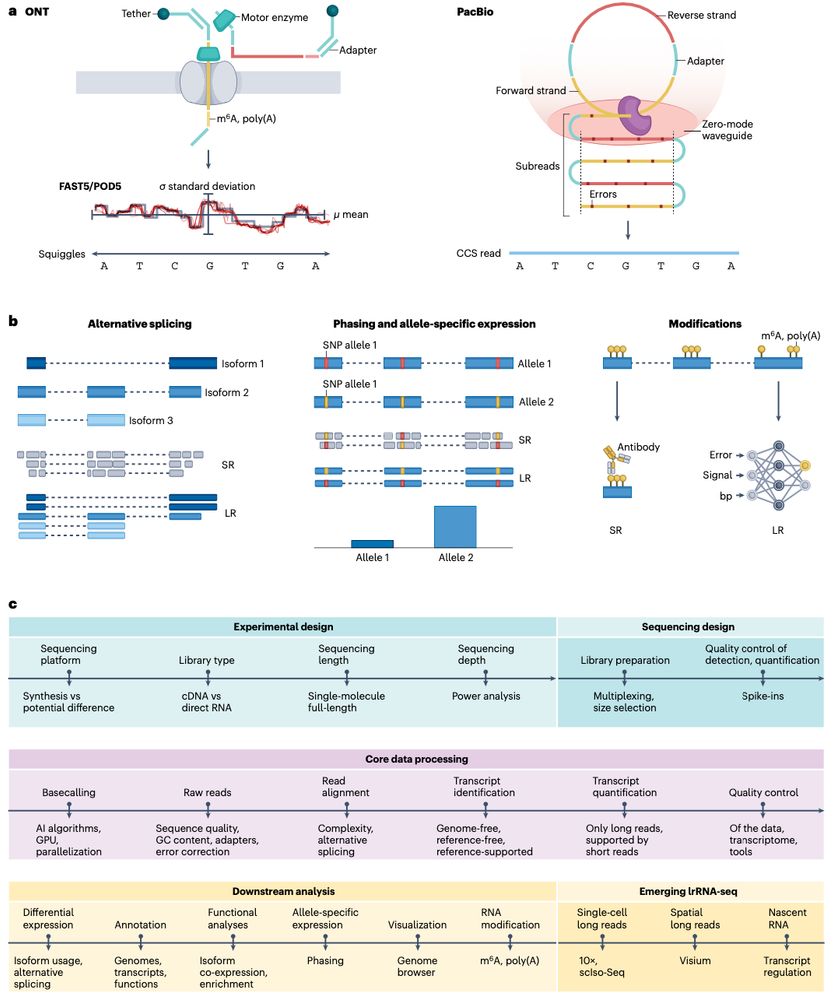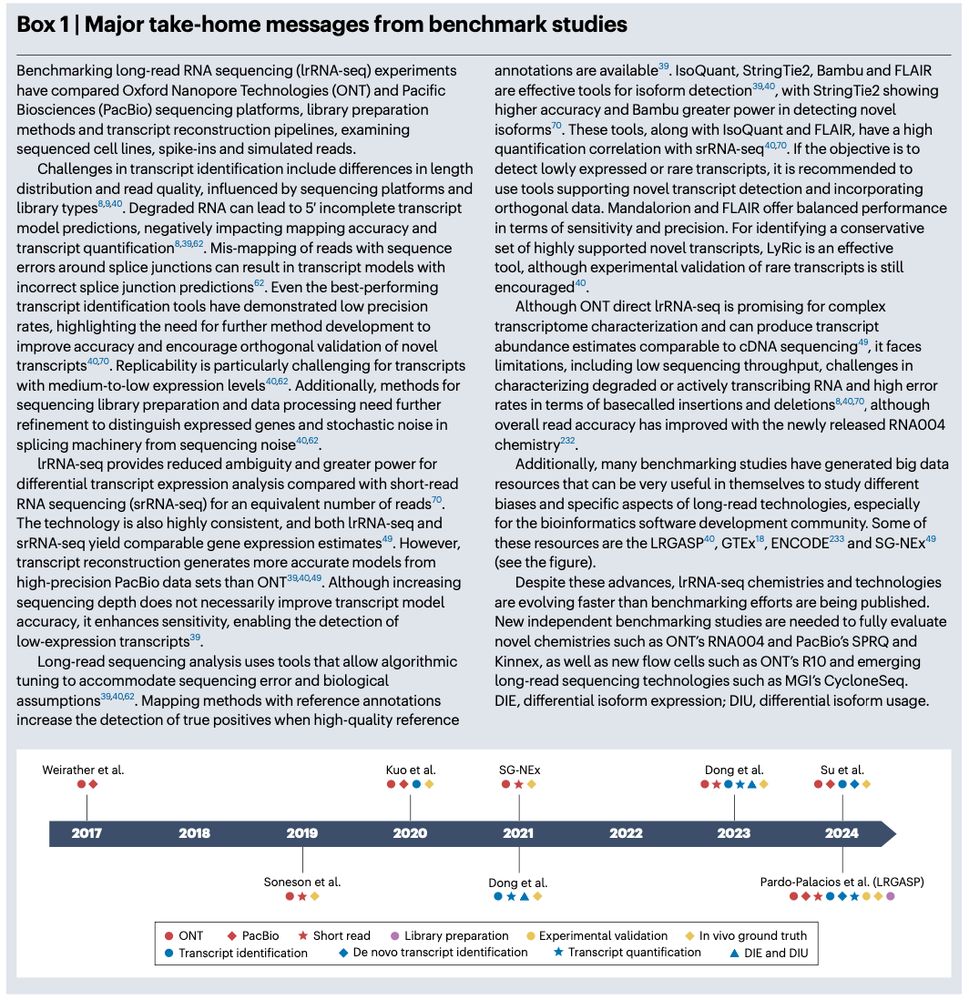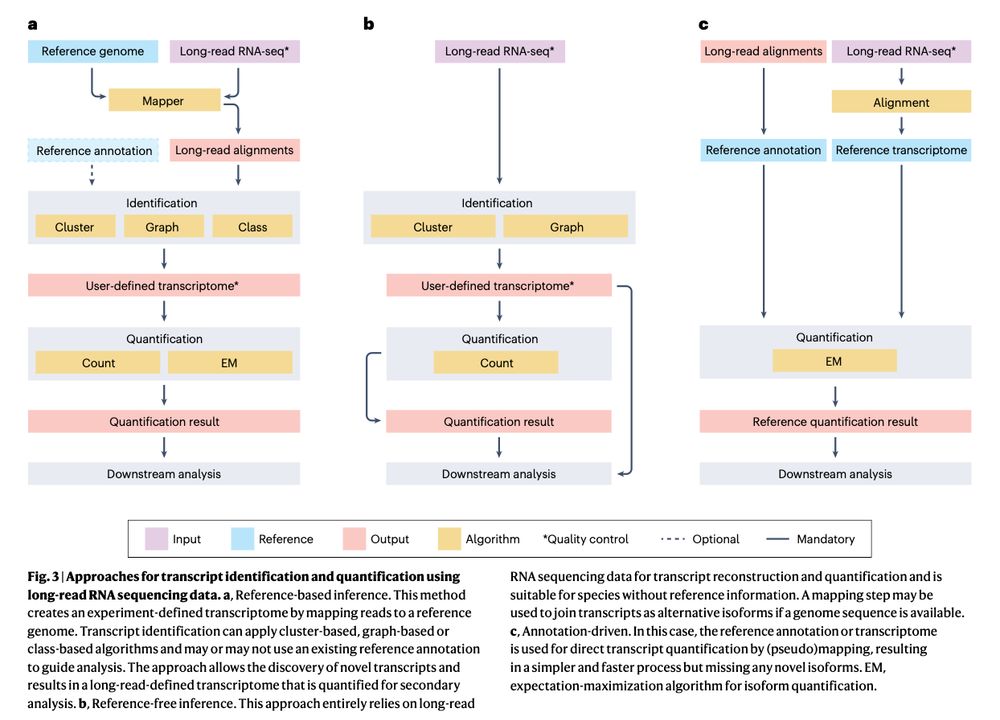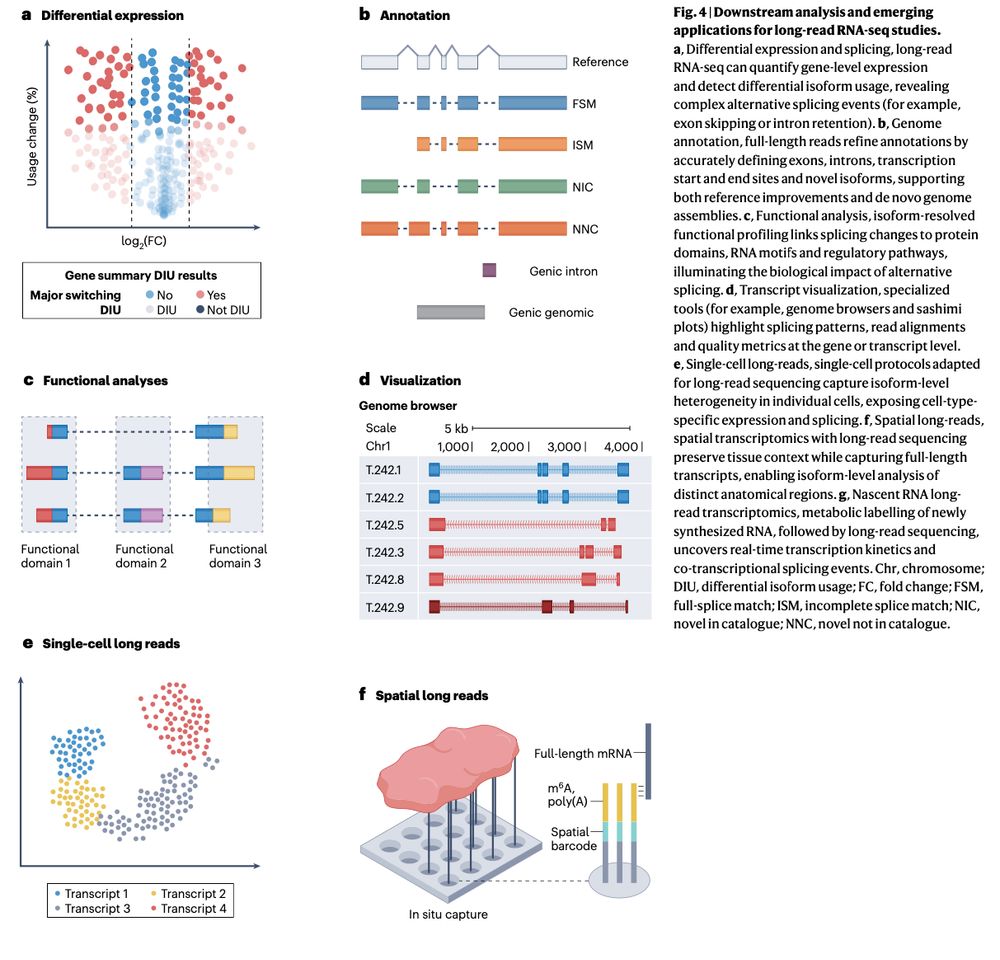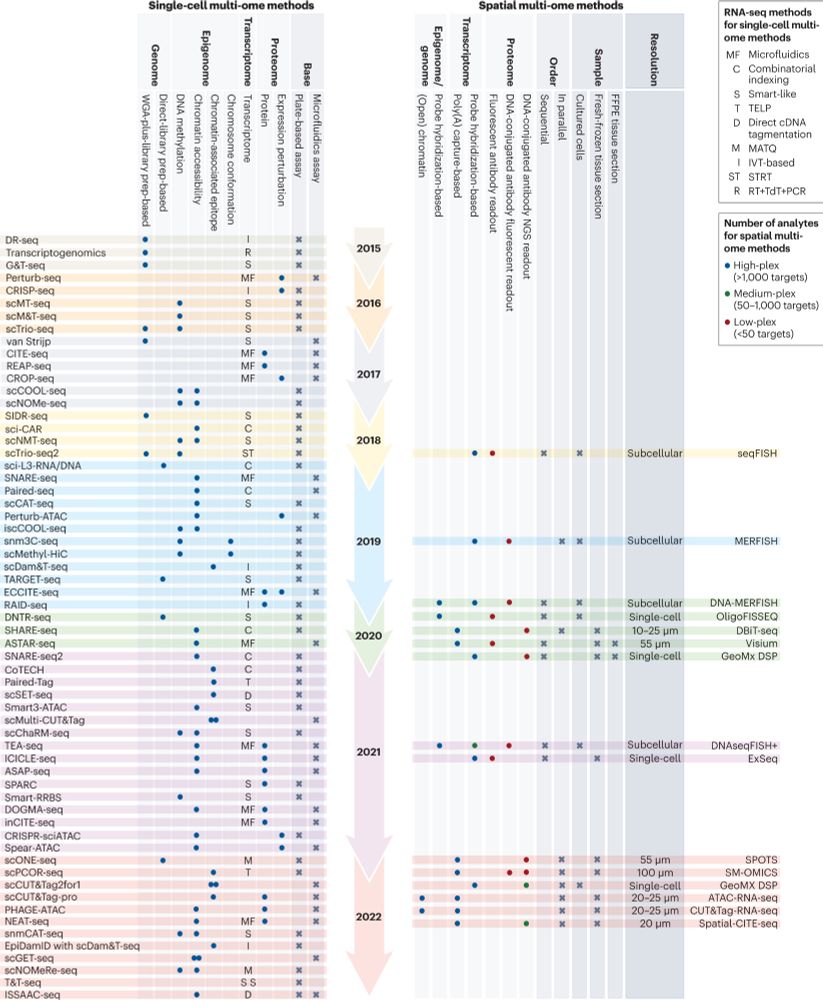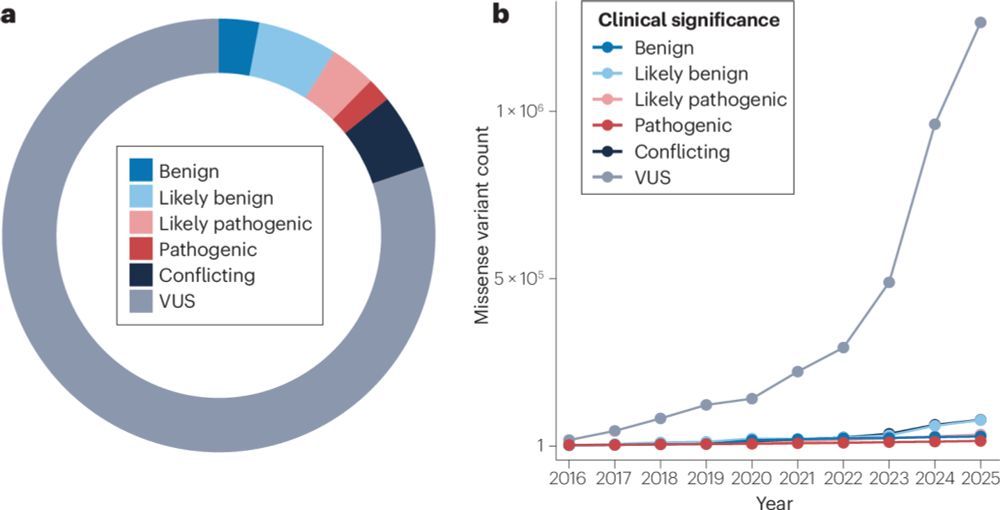
This is figure 1, which shows mutational burden and signature analysis in sperm and matched blood.
The findings of a study in Nature shed light on germline selection dynamics and highlight a broader increased disease risk for children born to fathers of advanced age than previously appreciated. go.nature.com/4h5BglX 🧬 🧪
12.10.2025 19:14 — 👍 22 🔁 10 💬 0 📌 0
A reminder that you can follow all of our journals with one click by using our starter pack!
17.03.2025 18:37 — 👍 86 🔁 28 💬 8 📌 4
Thanks, Ursula! X
17.09.2025 06:19 — 👍 1 🔁 0 💬 0 📌 0
🎉 25 years of NRG! Feels a bit bonkers to think I’ve been at the helm for almost 12 years 🤯 Where did the time go???
16.09.2025 19:37 — 👍 10 🔁 0 💬 1 📌 0
hey bluesky 👋 visa hurdles mean I’m looking for opportunities outside the US. I’m a computational biologist (bacterial + phage genomics, postdoc in Koonin’s group @ NIH). I am interested in teaming up on funding apps. reach out if this resonates!
15.09.2025 17:26 — 👍 70 🔁 91 💬 1 📌 3

Non-CG DNA methylation in animal genomes
Nature Genetics - This Review discusses noncanonical DNA methylation (mCH) in animal genomes and highlights the remaining need to clarify whether mCH represents a conserved regulatory layer or a...
Very happy to have contributed to this review on "non-CG" #methylation in animals now out in @natgenet.nature.com. Working again with @obog.bsky.social and Tirsa is always a pleasure. We think this not so well studied form of methylation should be more widely considered, please read: rdcu.be/eFAEk
11.09.2025 10:11 — 👍 43 🔁 16 💬 2 📌 1

Translon: a single term for translated regions - Nature Methods
Nature Methods - Translon: a single term for translated regions
There is a lack of general terminology for translated regions that does not depend on the properties of their products or their sequence.
Spearheaded by Pavel (Pasha) Baranov, this primer provides a unifying nomenclature for translation units: *Translon*
www.nature.com/articles/s41...
02.09.2025 09:21 — 👍 6 🔁 1 💬 0 📌 0
I'm not giving up my M-dash!!!
02.09.2025 11:13 — 👍 3 🔁 0 💬 0 📌 0

This is figure 1, which shows a summary of genomic findings for schizophrenia, bipolar disorder and depression.
A Review in Nature Reviews Genetics discusses how genomic advances have enhanced our understanding of schizophrenia, bipolar disorder and major depressive disorder, which could address limitations in diagnostic frameworks and future treatment strategies. go.nature.com/44bKTuy 🧬 🧪
23.06.2025 01:31 — 👍 32 🔁 10 💬 0 📌 1
If you enjoyed our RNA splicing collection, this @natrevdrugdiscov.nature.com Review may be of interest:
Protein isoform-centric therapeutics: expanding targets and increasing specificity go.nature.com/44HDClo
14.07.2025 08:27 — 👍 14 🔁 4 💬 1 📌 0
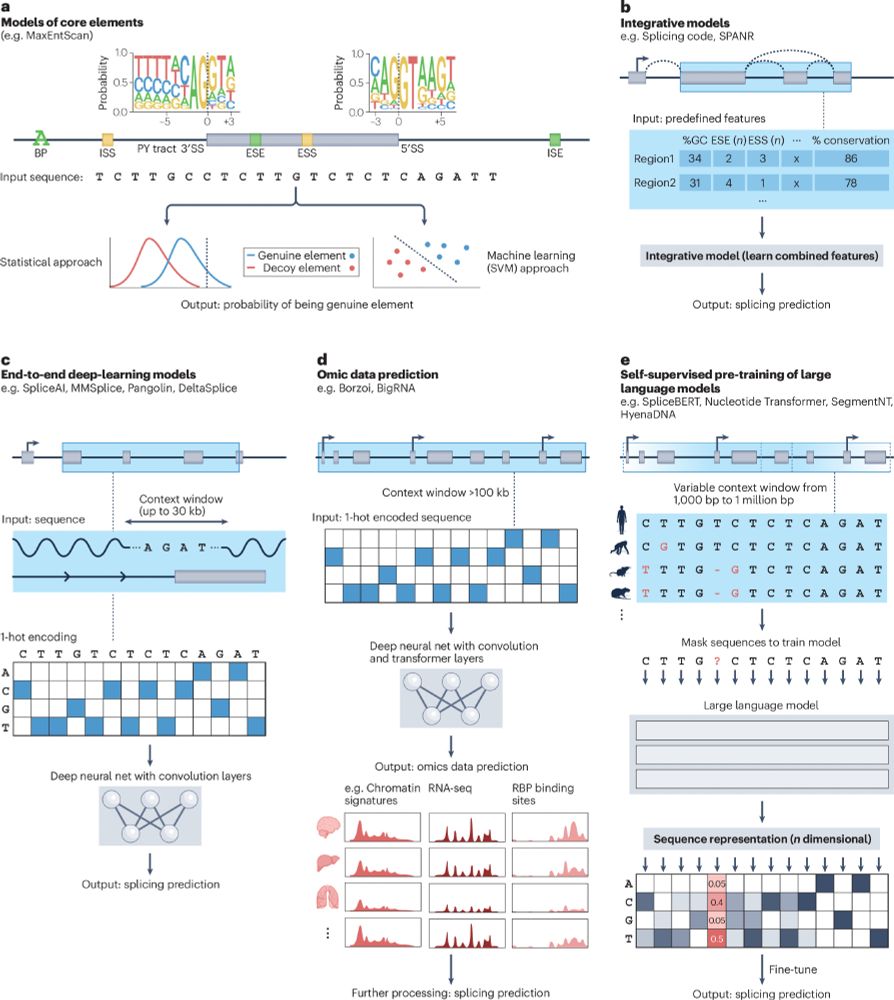
a, Early models built sequence motifs to describe the consensus sequences of individual core splicing elements, such as splice sites (SSs) and intronic and/or exonic enhancers and silencers. Statistical and machine-learning models were built to output the probability of a novel sequence acting as a core splicing element. The sequence logos shown for 5′SS and 3′SS were generated from Human hg38 RefSeq annotations (code available at https://www.github.com/ulelab/splicelogos). b, As our understanding of splicing mechanisms progressed, expert-selected features were extracted from sequences and used to train integrative models to predict splicing outcomes. c, With the advent of deep-learning, models could jointly learn features directly from raw sequence input. Although theoretically, sequence context could be as large as shown in part d, in practice smaller windows of up to 30 kb have been used. d, Supervised models with convolutional and transformer layers produce multimodal genome-wide data. These models use a much larger sequence context and can predict genome-wide data including RNA sequencing coverage, which can be further processed to evaluate splicing. e, By learning how to reconstruct partially masked genomic sequences across multiple species, self-supervised masked language models capture evolutionarily conserved sequence elements and their functional context in a very generic and flexible fashion. The informative numerical representations obtained by large language models can be used for splicing prediction tasks. Here 3′SS within different sequence contexts from multiple species are shown aligned for easier interpretation, but in practice sequences do not have to be aligned. Current masked language models with application to splicing use variable context windows from 1,000 to 1 million base pairs; however, it is currently unclear whether larger context windows confer better performance
Evolution of splicing model architectures go.nature.com/4eweliE
Figure from our recent Review: From computational models of the splicing code to regulatory mechanisms and therapeutic implications (free to read here: rdcu.be/dVNV4)
02.07.2025 10:21 — 👍 20 🔁 8 💬 0 📌 0
What gif pops up when you type your name
15.08.2025 06:40 — 👍 2 🔁 0 💬 0 📌 0

Our August 2025 issue is now live: go.nature.com/4kIXzOI
Topics include: systems biology in the single-cell era; ADAR1-mediated RNA editing; retrotransposable element reactivation and its biological impact; transcriptional condensates as temporal signal integrators; X-linked competition
18.07.2025 08:03 — 👍 12 🔁 2 💬 1 📌 0
We (with Clement Coclet, not on Bsky) had the chance to work on a broad "state of viromics" review. We tried to use this to give an overview of how the field changed over the last ~ 15 years, and also what we think are some of the major remaining challenges. Full-text access at -> rdcu.be/excHt
22.07.2025 15:06 — 👍 84 🔁 41 💬 2 📌 2
New review article with @mmdesai.bsky.social is out today! Grateful for the opportunity to contribute something we hope will serve the community well
21.07.2025 17:30 — 👍 47 🔁 15 💬 3 📌 0
More equitable methods are needed to ensure genomic research benefits everyone fairly, according to a new review article in Nature Reviews Genetics involving Genomics England researchers.
Find out more: www.nature.com/articles/s41...
@natrevgenet.nature.com
15.05.2025 16:24 — 👍 4 🔁 3 💬 0 📌 0
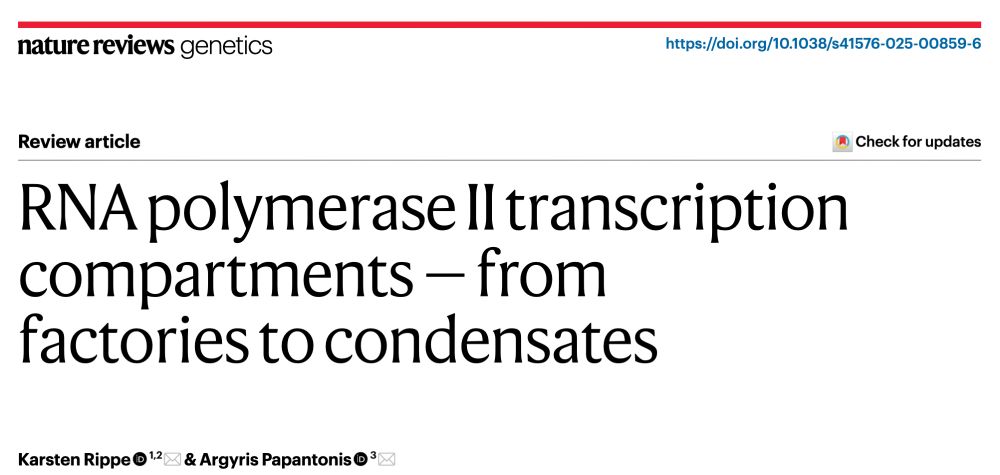
This is a piece that I and @karsten-rippe.bsky.social discussing a lot, and a topic that is very close to my heart. The editors @naturerevgenet.bsky.social gave us the stage to do so, and the final version of our review is now available under this link: rdcu.be/erP1u
A short thread follows 1/n
19.06.2025 16:37 — 👍 95 🔁 39 💬 3 📌 2

Our July 2025 issue is now live: go.nature.com/3ZzmXyQ
Topics include: structural variation in the human genome; cytoplasmic mRNA decay; the mammalian segmentation clock; genetic models and genomic studies of cancer metastasis
19.06.2025 13:06 — 👍 6 🔁 2 💬 1 📌 0
Just in time for #RNA2025 #RNA25!
28.05.2025 08:10 — 👍 7 🔁 2 💬 0 📌 0

RNA ribbon that is being cut and re-stitched together, representing pre-mRNA splicing of introns and exon ligation
Our June issue is live and includes an editorial on RNA splicing (go.nature.com/3SdWVgk) that acts as a foreword for a new joint collection by @natrevgenet.nature.com and @natrevmcb.nature.com on this topic (go.nature.com/3H0vEvp)
21.05.2025 14:51 — 👍 17 🔁 3 💬 1 📌 4
Deputy Editor, @commsbio.nature.com. Formerly on the @natureportfolio.nature.com Research Cross-Journal Team. 🐶 dad to Darwin. Opinions are mine (or typos). 🏳️🌈
Mom, mentor, microbial ecologist. Soil biogeochemistry, climate change, CDR, roots-microbes-minerals, stable isotope probing metagenomics, NanoSIMS. Lead of LLNL Carbon Initiative, Roads2Removal.org, Microbes Persist SFA, & Terraforming Soil Earthshot Ctr.
The Epigenetic Face of Cancer Metabolism Lab
We study NUCLEAR METABOLISM at CRG, Barcelona
https://sdelcilab.crg.eu/
🔬 Assistant Prof, Pathology @Duke | Director, Clin Micro Lab
🧫 Former Clin Micro Fellow @Memorial Sloan Kettering
👩🏻🔬 Former Postdoc @broadinstitute.org
🎓 PhD @The Rockefeller University
Focus: Diagnostics, AMR, Structural Biology
#UniKöln #UniCologne // Impressum: http://ukoeln.de/3JGDD
Mastodon ➡ @UniKoeln@Wisskomm.social
The #CRC1218 tackles the challenge of understanding how #mitochondria communicate with the rest of the #cell to regulate fundamental processes. Funded by #dfg
https://sfb1218.uni-koeln.de/
Palaeoanthropologist at the Natural History Museum London.
Posts are my own, and when I repost or like, it does not signify I necessarily agree with all content https://www.nhm.ac.uk/our-science/departments-and-staff/staff-directory/chris-stringer.html
Principal Investigator at https://www.cabd.es | Interested in developmental epigenomics | Coordinator of the DANIO-ReCODE MSCA DN | https://danio-recode.eu | @daniorecode.bsky.social | webpage: www.bogdanoviclab.org
Evolutionary epigenomics ( eukaryotes / Transcription Factors / Transposable Elements / DNA methylation ) @ QMUL (London).
Lab website: https://www.demendozalab.com/
typing...
(also active on X as @cees_dekker)
America’s Finest News Source. A @globaltetrahedron.bsky.social subsidiary.
Get the paper delivered to your door: membership.theonion.com
Professor of Haematology at University College London Cancer Institute and Great Ormond Street Institute of Child Health. Clinician scientist investigating, caring for and developing new therapies for patients with acute leukaemia
Biologist studying evolution, development, and gene-regulation. Group leader at EMBL, Heidelberg. Climber.
Official account of Lawrence Berkeley National Laboratory (LBNL), a U.S. Department of Energy national lab. newscenter.lbl.gov
Assoc Prof at Karolinska Institutet. Dev bio enthusiast, from liver to brain, and Notch to miRs, cell fates and lineages..
www.anderssonlab.com
Human B cell responses to emerging pathogens 🦠
Icahn School of Medicine at Mount Sinai, NYC 🏙 🚕 🗽🍎
www.coelholab.com
Genomics, technology and human genetics @University of Washington. Working to create an atlas of variant effects and resolve VUS.
Studying cellular #stress responses, particularly #senescence and its impact on #immune response, #ageing and #cancer, #tumorigenesis at Cancer Research UK CI @cruk-ci.bsky.social, University of Cambridge @cam.ac.uk
Website: naritalab.com
SFB1361 "Regulation of DNA Repair and Genome Stability"
Imprint: https://sfb1361.de/imprint
We study how organisms grow, age & develop disease through basic research in epigenetics, genome stability & related fields 🧬
www.imb.de / Imprint: https://www.imb.de/impressum-imprint
📍 #Mainz, Germany





